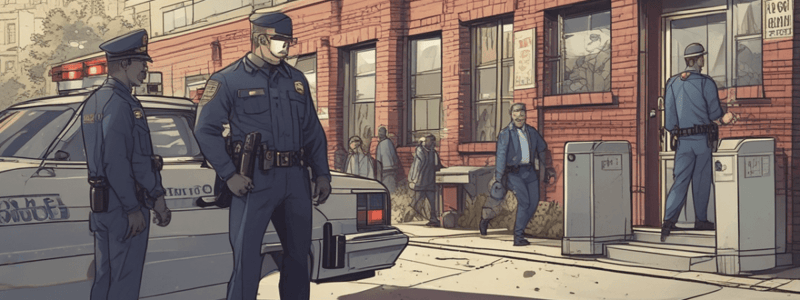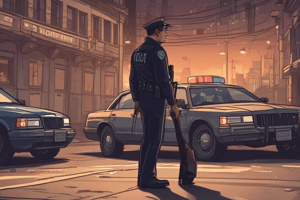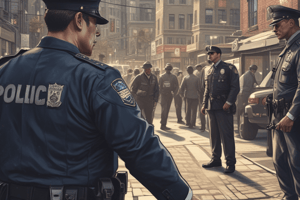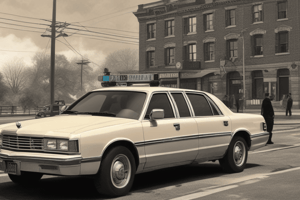Podcast
Questions and Answers
What is the main reason a police officer should conduct a thorough search of a person?
What is the main reason a police officer should conduct a thorough search of a person?
- To establish probable cause or reasonable suspicion
- To prolong the investigation and gather more evidence
- To ensure personal safety and prevent potential harm (correct)
- To intimidate or dominate the suspect
Which of the following behaviors would most likely indicate a suspect's nervousness during a field interview?
Which of the following behaviors would most likely indicate a suspect's nervousness during a field interview?
- Listening attentively to the officer's questions
- Maintaining direct eye contact
- Providing concise and clear answers
- Fidgeting or shaking (correct)
What is the primary objective of a frisk search?
What is the primary objective of a frisk search?
- To intimidate the suspect
- To discover contraband or evidence
- To prolong the investigation
- To discover weapons and ensure officer safety (correct)
Which of the following circumstances would justify a frisk search?
Which of the following circumstances would justify a frisk search?
What would be a valid reason to suspect that a person may be carrying a weapon or contraband?
What would be a valid reason to suspect that a person may be carrying a weapon or contraband?
What is an example of a verbal element that may aid in establishing probable cause or reasonable suspicion?
What is an example of a verbal element that may aid in establishing probable cause or reasonable suspicion?
Under what circumstances can a body cavity search be conducted?
Under what circumstances can a body cavity search be conducted?
What is the recommended position for an arrested person to be handcuffed?
What is the recommended position for an arrested person to be handcuffed?
Why is the prone position considered the best for temporarily incapacitating a suspect?
Why is the prone position considered the best for temporarily incapacitating a suspect?
What is the purpose of handcuffing an arrested person?
What is the purpose of handcuffing an arrested person?
What is the recommended way to position the palms when handcuffing an arrested person?
What is the recommended way to position the palms when handcuffing an arrested person?
What is the purpose of a vehicle search?
What is the purpose of a vehicle search?
What is necessary to justify a warrantless search of a vehicle?
What is necessary to justify a warrantless search of a vehicle?
What may suggest that something is wrong during a traffic stop?
What may suggest that something is wrong during a traffic stop?
What is a common and important area of patrol duty?
What is a common and important area of patrol duty?
What is the recommended position for a suspect during a kneeling search?
What is the recommended position for a suspect during a kneeling search?
What is the primary reason for conducting a search incident to arrest?
What is the primary reason for conducting a search incident to arrest?
When searching a female suspect, what technique should a male officer use to avoid allegations of impropriety?
When searching a female suspect, what technique should a male officer use to avoid allegations of impropriety?
What is the purpose of having a suspect kneel with their fingers intertwined behind their neck or head?
What is the purpose of having a suspect kneel with their fingers intertwined behind their neck or head?
When can a body cavity search be conducted?
When can a body cavity search be conducted?
Why should a male officer call a female officer for assistance when searching a female suspect?
Why should a male officer call a female officer for assistance when searching a female suspect?
What is the primary goal of searching a suspect?
What is the primary goal of searching a suspect?
What is the definition of a strip search?
What is the definition of a strip search?
In what circumstances can a strip search be conducted?
In what circumstances can a strip search be conducted?
What is the purpose of searching a suspect's waistband first?
What is the purpose of searching a suspect's waistband first?
Why should an officer not 'search short' when searching a suspect?
Why should an officer not 'search short' when searching a suspect?
What may be concluded if a vehicle is reported to have been involved in an armed robbery?
What may be concluded if a vehicle is reported to have been involved in an armed robbery?
What may indicate that occupants are hiding something?
What may indicate that occupants are hiding something?
Why might a driver and front-seat occupant change seats during a traffic stop?
Why might a driver and front-seat occupant change seats during a traffic stop?
What may be a reason to search a vehicle?
What may be a reason to search a vehicle?
What may be seized without a warrant?
What may be seized without a warrant?
What allows an officer to search a vehicle without a warrant?
What allows an officer to search a vehicle without a warrant?
What may be searched incident to arrest?
What may be searched incident to arrest?
Why might an officer radio for backup during a traffic stop?
Why might an officer radio for backup during a traffic stop?
What may indicate furtive movements?
What may indicate furtive movements?
What may be a reason to frisk a motorist?
What may be a reason to frisk a motorist?
What is the primary purpose of conducting a routine warrantless inventory search of a lawfully impounded automobile?
What is the primary purpose of conducting a routine warrantless inventory search of a lawfully impounded automobile?
When searching a vehicle, what should an officer do to avoid becoming apathetic and to maintain control of the situation?
When searching a vehicle, what should an officer do to avoid becoming apathetic and to maintain control of the situation?
What is the recommended procedure when searching a vehicle with multiple occupants?
What is the recommended procedure when searching a vehicle with multiple occupants?
During a vehicle search, what should an officer do to ensure their own safety?
During a vehicle search, what should an officer do to ensure their own safety?
What should an officer do when searching a vehicle with a single occupant?
What should an officer do when searching a vehicle with a single occupant?
Why should an officer not search an occupied vehicle at night?
Why should an officer not search an occupied vehicle at night?
What should an officer do when searching a vehicle with a lawfully impounded automobile?
What should an officer do when searching a vehicle with a lawfully impounded automobile?
What is the primary purpose of a thorough search of a vehicle?
What is the primary purpose of a thorough search of a vehicle?
What should an officer do when searching a vehicle with a suspicious occupant?
What should an officer do when searching a vehicle with a suspicious occupant?
What should an officer do when conducting a vehicle search?
What should an officer do when conducting a vehicle search?
Study Notes
Search of Persons
- A sloppy search can be life-threatening, and court cases may be affected by the conduct of a personal search.
- Verbal and non-verbal elements that aid in establishing probable cause or reasonable suspicion:
- Suspect's refusal or reluctance to answer direct investigative questions
- Over-informative answers to direct investigative questioning
- Refusal to make normal eye contact during field interview
- Changing walking pace, pattern, or direction when the officer is first notified
- Voice shaking or trembling during field interview
- Appearing nervous and fidgety during field interrogation
- Suspect known to carry weapons or contraband
- Reaching into pockets upon noticing officer presence
Types of Searches
- Frisk: a carefully limited search of the outer clothing to discover weapons
- Search incident to arrest: a warrantless search of the arrested person and surrounding area
- Incapacitate person: techniques to temporarily incapacitate a suspect, including handcuffing and prone or kneeling positions
- Search methods:
- Waistband search first, then systematic head-to-foot search
- Do not assume that finding one weapon means there are no others
- Male officers searching female persons: use techniques to guard against allegations of impropriety/molestation
- Use a pen or mini-flashlight to search, and avoid using fingers to touch
Searching Persons
- Three positions most utilized by officers:
- Standing
- Kneeling
- Prone
- Standing position:
- Utilize a wall or other vertical surface
- Greatest risk to the officer
- Kneeling position:
- Used in open areas
- Have suspect kneel, facing away from the officer, with fingers intertwined behind their head or neck and ankles crossed
- Offers more protection for the officer
- Prone position:
- Probably the best position to use to incapacitate a suspect
- Order the suspect to go down on the ground on their stomach, face down, with arms outstretched and palms up
- Offers the most protection for the officer
Strip Search and Body Cavity Search
- Strip search: removal or rearrangement of clothing to permit an inspection of genitals, buttocks, anus, breasts, or undergarments
- Body cavity search: inspection of a person's anus or genitalia
- Both require probable cause to believe the person is concealing a weapon, evidence, or contraband
General Information - Methods
- An arrested person should be handcuffed first, prior to searching
- Approach from the subject's rear
- Do not attempt to handcuff/search more than one person by yourself
- Take your time and search thoroughly
- Keep gun side away from the suspect
Handcuffing in Arrest Situations
- Purpose:
- Safety of the officer
- Control
- Minimize escape possibilities
- Techniques:
- Always handcuff behind the back with palms facing out
- Palms positioned inward permit grabbing and holding
Vehicle Searches
- Vehicle searches are a common and important area of patrol duty
- Major crimes are often discovered as a result of vehicle stops and searches
- Physical and verbal elements that may establish probable cause and justify warrantless search of vehicles:
- Movement of the vehicle
- Verbal threats made to the officer
- Number of occupants in the vehicle
- Nature of the offense in which the vehicle is/was involved
- Behavior of occupants (danger signs)
- Furtive movements
- Type of vehicle involved and knowledge of weapons involved
- Suspect vehicle turning at a 45-degree angle toward the police when being stopped
Methods of Vehicle Search
- Frisking a motorist: stop and frisk a motorist if all stop and frisk criteria are met
- Search incident to arrest of persons in a vehicle: search the passenger compartment and any containers inside
- Plain view: seize items in plain view at the time of an arrest if there is probable cause to believe the items are contraband or evidence
- Motor vehicle exception: conduct a warrantless search of the car at another time and place if the car was in motion or mobile at the time of arrest
- Inventory procedure: conduct a routine warrantless inventory search of the passenger area, including the glove compartment, or any lawfully impounded automobiles
Studying That Suits You
Use AI to generate personalized quizzes and flashcards to suit your learning preferences.
Description
This quiz covers the procedures and protocols for police officers to conduct searches of persons, including establishing probable cause and reasonable suspicion. It also discusses the importance of proper search techniques for personal safety and the impact on court cases.




